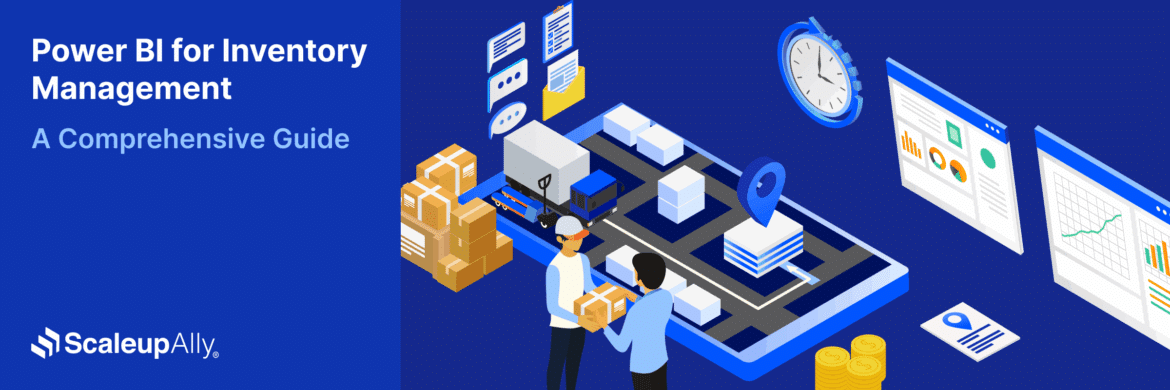
11 Business Intelligence Trends Shaping the Future of Data-Driven Decisions
Tarsem Singh | May 12, 2024 , 10 min read
Table Of Content
Business Intelligence (BI) plays a role in enabling organizations to make informed decisions based on comprehensive data analysis. As the volume and complexity of data continue to grow, the need for effective BI tools and strategies becomes increasingly important.
This article discusses the significance of BI in driving data-driven decisions and explores 11 key trends shaping the future of Business Intelligence.
By understanding and adapting to these trends, businesses can position themselves to leverage data effectively and gain a competitive edge in the marketplace.
The Rise of Data-Driven Decisions
The increasing volume and complexity of data in the business world is staggering. With the proliferation of digital technologies, businesses are generating and collecting massive amounts of data from various sources such as customer interactions, sales transactions, social media, and more.
Traditional methods of data analysis, such as manual spreadsheet-based approaches, are becoming insufficient in handling the sheer scale and intricacy of this data.
To make sense of this big data, businesses need advanced BI tools and techniques that can efficiently process, analyze, and visualize large datasets. These tools can provide valuable insights and trends that would otherwise remain hidden in the vast sea of information, enabling informed decision-making and strategic planning.
Therefore, the need for advanced BI tools and techniques has become paramount in order to extract meaningful and actionable intelligence from big data.
11 Business Intelligence Trends To Watch Out for in 2024
Let us examine 11 key business intelligence trends that are set to make a significant impact in 2024. From augmented analytics to AI-driven insights, these trends are poised to revolutionize the way organizations harness data for informed decision-making.
1. Augmented Analytics (powered by AI and Machine Learning)
Augmented analytics integrates artificial intelligence and machine learning algorithms into BI tools to enhance data analysis and decision-making processes.
By automating data preparation, insight discovery, and interpretation, augmented analytics enables businesses to uncover valuable insights from their data more efficiently.
This trend in BI empowers users with advanced analytical capabilities, enabling them to focus on strategic decision-making rather than spending time on manual data analysis.
For example, using augmented analytics, a retail company can quickly identify customer purchasing patterns and preferences to optimize its product offerings and marketing strategies.
Also read: How Business Intelligence is Beneficial for Retail Industry?
2. Cloud-Based BI Solutions
Cloud-based BI solutions leverage cloud infrastructure to provide scalable, flexible, and cost-effective access to BI tools and data storage.
This allows businesses to access and analyze data from anywhere, at any time, using a variety of devices. Cloud-based BI solutions reduce operational costs and offer seamless collaboration among geographically dispersed teams by eliminating the need for on-premises infrastructure and maintenance.
For instance, a healthcare organization can use cloud-based BI to securely access and analyze patient data from multiple locations, facilitating timely decision-making and improving patient care.
3. Collaborative BI and Data Sharing
Collaborative BI emphasizes shared data insights and collaborative decision-making within an organization. Using collaborative BI and data sharing enables teams to work together on data analysis and interpretation, fostering knowledge sharing and collective problem-solving.
By facilitating data sharing and collaboration, businesses can accelerate decision-making processes and improve overall operational efficiency.
Take a manufacturing company for example. They can use collaborative BI to enable cross-functional teams to analyze production data and identify process optimization and quality improvement opportunities.
4. Self-service BI and User-Friendly Interfaces
Self-service BI empowers non-technical users to access and analyze data using intuitive, user-friendly interfaces independently. This BI trend reduces the reliance on IT departments for generating reports and conducting ad-hoc analysis, enabling business users to derive insights directly from the data.
Self-service BI tools allow users to create customized dashboards, reports, and visualizations without extensive technical knowledge.
For instance, a financial services firm can use BI to enable financial analysts to explore and visualize market trends, empowering them to make timely investment decisions.
5. Advanced Data Visualization Techniques
Advanced data visualization techniques utilize interactive and immersive visualizations to represent complex data sets in a meaningful and comprehensible manner. This is yet another future trend in business intelligence tha enables users to gain deeper insights and identify patterns, trends, and outliers within their data.
Advanced data visualization techniques enhance decision-making by presenting data in a visually engaging and easily understandable format.
For example, an e-commerce company can use business intelligence along with advanced data visualization to create interactive dashboards that provide real-time insights into customer behavior and sales performance, facilitating quick and informed decision-making.
6. Mobile Business Intelligence (Mobile BI)
Mobile BI facilitates access to BI tools and data on mobile devices, enabling users to stay informed and make decisions on the go. This trend empowers the mobile workforce by providing real-time access to critical business information, KPIs, and reports.
Mobile BI supports remote decision-making and enhances operational agility, particularly for industries with field-based operations.
For instance, a logistics company can use mobile BI to provide delivery drivers with real-time route optimization and performance analytics, improving delivery efficiency and customer satisfaction.
7. Natural Language Processing (NLP) for BI
Natural language processing (NLP) enables BI tools to interpret and respond to human language inputs, allowing users to interact with data using natural language queries and commands.
NLP’s integration with BI simplifies data access and analysis, making BI tools more accessible to a wider audience within an organization. NLP for BI enhances user experience and productivity by enabling users to engage with data conversationally.
For example, a sales team can use NLP for BI to ask questions about sales performance and trends, receiving instant and actionable insights without the need for complex query languages or technical skills.
8. Edge Computing
Edge computing brings data processing and analysis closer to the data source, reducing latency and enabling real-time decision-making at the edge of the network.
Edge computing for BI allows businesses to analyze and act on data at the point of generation, supporting use cases such as predictive maintenance, remote monitoring, and personalized customer experiences.
For example, a smart energy grid can leverage edge computing along with BI to analyze energy consumption patterns and optimize power distribution in real-time, improving operational efficiency and grid reliability.
9. Embedded Analytics
Embedded analytics integrates BI capabilities directly into existing business applications, workflows, and processes, bringing data-driven insights to the point of decision-making.
This trend in business intelligence enables users to access relevant analytics within the context of their daily activities, eliminating the need to switch between multiple applications. Embedded analytics enhances user adoption and decision-making by providing seamless access to insights where they are needed most.
For instance, a human resources management system can embed analytics to provide HR professionals with real-time workforce performance metrics and predictive insights, enabling informed talent management and strategic workforce planning.
10. Focus on Data Governance and Data Security
The increasing focus on data governance and data security emphasizes the importance of establishing policies and controls to ensure data quality, integrity, and security.
Data governance and security has always been at the centre of BI. Data security and givernance addresses concerns related to data privacy, regulatory compliance, and protection against data breaches and cyber threats.
By implementing effective data governance and security measures, businesses can build trust in their data assets and mitigate unauthorized access and data misuse risks.
For example, a financial institution can implement data governance and security protocols to protect sensitive customer financial data and ensure compliance with industry regulations, safeguarding the integrity and confidentiality of the data.
11. The Increasing Role of Ethical AI in BI
The increasing role of ethical AI in BI emphasizes the ethical and responsible use of artificial intelligence algorithms and models in data analysis and decision-making processes.
Complying with these ethical standards promotes transparency, fairness, and accountability in AI-driven insights and recommendations, addressing concerns about bias, discrimination, and ethical implications of AI applications.
By integrating ethical AI principles into BI workflows, businesses can ensure that their data-driven decisions are unbiased, and aligned with social values.
For example, a healthcare organization can leverage ethical AI in BI to ensure fairness and transparency in patient diagnosis and treatment recommendations, enhancing healthcare outcomes and patient’s trust in AI-powered medical decision support systems.
Also read: Healthcare Business Intelligence: Enhancing Healthcare Industry
Conclusion
The 11 Business Intelligence trends discussed above are poised to shape the future of data-driven decision-making significantly. Embracing augmented analytics, cloud-based BI solutions, collaborative data sharing, self-service BI, advanced data visualization techniques, mobile business intelligence, and other emerging trends can empower organizations to harness the full potential of their data and gain a competitive edge in the market.
As the future of the business intelligence landscape evolves, businesses and professionals must adapt to these trends and leverage the latest BI tools and strategies. By staying informed and embracing the transformative power of BI, organizations can position themselves to make more informed, data-driven decisions, drive innovation, and achieve sustainable growth.
It’s crucial for businesses to actively consider these BI trends, explore how they can be implemented within their organizations, and stay agile in the rapidly changing world of business intelligence.
By doing so, you can unlock new opportunities and stay ahead in an increasingly data-driven business environment.
Frequently Asked Questions (FAQs)
Q: What are the biggest challenges businesses face in adopting new BI trends?
Adopting new business intelligence (BI) trends can pose several business challenges. One major obstacle is ensuring data quality and integration, as organizations must manage data from various sources while maintaining accuracy and consistency. Another challenge is the skill gap, as there may be a shortage of professionals who can effectively interpret data and implement BI solutions. Additionally, cost is a significant consideration, as implementing and maintaining BI tools can be expensive, particularly for smaller businesses. Resistance to change among employees and security concerns regarding protecting sensitive data are also common challenges in adopting new BI trends.
Q: How can businesses ensure they choose the right BI tools for their needs?
To select the most suitable BI tools for their needs, businesses should first identify their specific requirements and objectives. It’s essential to thoroughly research and compare different BI tools based on their features, scalability, and compatibility with existing systems. User-friendliness is another crucial factor, as employees are more likely to adopt intuitive tools. Businesses should also consider the scalability of the BI tool to ensure it can accommodate future growth and handle increasing data volumes. Furthermore, choosing a reputable vendor with a track record of providing reliable BI solutions and excellent customer support can help ensure the right choice.
Q: What is the future outlook of business intelligence?
The future of BI is poised for significant advancements, driven by several key trends. AI and machine learning are expected to be more prominent in BI tools, enabling advanced analytics and predictive insights. Data democratization will also likely increase, making data accessible to non-technical users through self-service BI tools. Real-time analytics will become more prevalent, allowing businesses to make quicker and more informed decisions. Cloud adoption is expected to rise as more businesses move their BI systems to the cloud for increased flexibility and scalability. Finally, there will be a greater focus on data governance as organizations strive to ensure compliance with data regulations.
Related Blogs

Data Warehouse Cost Breakdown: Factors, Pricing Models & Platform Comparison
Discover how much a data warehouse costs in 2025. Explore pricing models, key factors, and platform comparisons to plan your data budget effectively.
Tarsem Singh
Nov 6 ,
14 min read

How Much Do Integrations Cost? [Pricing Breakdown & Key Insights]
Learn how much integrations cost, key factors influencing pricing, hidden expenses to avoid, and effective ways to reduce integration costs.
Tarsem Singh
Nov 6 ,
9 min read

Power BI for Inventory Management: A Comprehensive Guide
Explore the hidden power of Power BI for inventory management and how it provides businesses with powerful analytics and visualization capabilities.
Tarsem Singh
Oct 8 ,
19 min read


